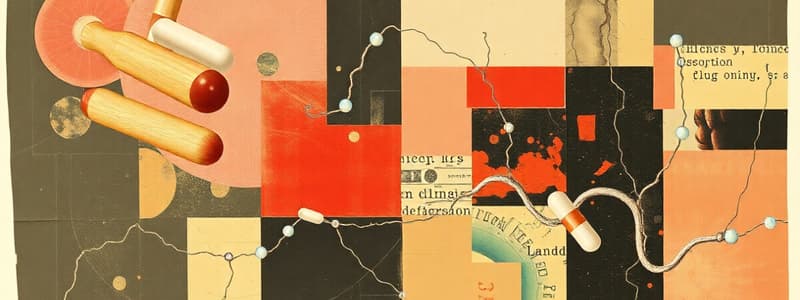Podcast
Questions and Answers
What effect does contraction of sphincters and relaxation of the bladder wall have on urine?
What effect does contraction of sphincters and relaxation of the bladder wall have on urine?
- Increases urine flow
- Decreases bladder capacity
- Causes urine retention (correct)
- Promotes frequent urination
What is a result of decreased HCL secretion in the body?
What is a result of decreased HCL secretion in the body?
- Decreased motility and constipation (correct)
- Increased digestive enzyme production
- Increased gastric motility
- Decreased nutrient absorption
Relaxation of which structure occurs during specific physiological processes?
Relaxation of which structure occurs during specific physiological processes?
- Cardiac muscle
- Sphincters
- Uterine wall (correct)
- Bladder wall
What can excessive contraction of sphincters lead to?
What can excessive contraction of sphincters lead to?
What condition may arise from decreased motility due to reduced HCL secretion?
What condition may arise from decreased motility due to reduced HCL secretion?
Which of the following is a potential side effect of β2?
Which of the following is a potential side effect of β2?
What condition is a contraindication for the use of β2 medication?
What condition is a contraindication for the use of β2 medication?
Which of the following is NOT mentioned as a side effect of β2?
Which of the following is NOT mentioned as a side effect of β2?
What is a noted side effect related to dreams when using certain medications like β3?
What is a noted side effect related to dreams when using certain medications like β3?
Which of the following conditions is NOT classified as a contraindication for β2?
Which of the following conditions is NOT classified as a contraindication for β2?
What is the most important source of natural drugs?
What is the most important source of natural drugs?
What is the legal status of Clenbuterol for athletes?
What is the legal status of Clenbuterol for athletes?
Which of the following is a natural drug derived from an animal source?
Which of the following is a natural drug derived from an animal source?
What type of effect does Clenbuterol have?
What type of effect does Clenbuterol have?
Which microorganism is known for producing an important antibiotic?
Which microorganism is known for producing an important antibiotic?
Which of the following options is NOT a source of natural drugs?
Which of the following options is NOT a source of natural drugs?
For which condition was Clenbuterol previously used?
For which condition was Clenbuterol previously used?
What mineral is typically found in soil as a source of drugs?
What mineral is typically found in soil as a source of drugs?
How long is the duration of Clenbuterol's effects?
How long is the duration of Clenbuterol's effects?
What is a reason for the current non-use of Clenbuterol in treating asthma?
What is a reason for the current non-use of Clenbuterol in treating asthma?
What process describes the conversion of drugs from an active lipid-soluble state to an inactive water-soluble state for excretion?
What process describes the conversion of drugs from an active lipid-soluble state to an inactive water-soluble state for excretion?
Which term refers to the conversion of inactive forms of drugs into their active forms?
Which term refers to the conversion of inactive forms of drugs into their active forms?
Captopril is an example of which type of drug transformation?
Captopril is an example of which type of drug transformation?
Why do drugs need to be converted from lipid-soluble to water-soluble forms?
Why do drugs need to be converted from lipid-soluble to water-soluble forms?
What is a common characteristic of prodrugs like captopril?
What is a common characteristic of prodrugs like captopril?
What is the primary focus of the content provided?
What is the primary focus of the content provided?
Which of the following could be considered irrelevant to the topic at hand?
Which of the following could be considered irrelevant to the topic at hand?
Which area is least likely to be related to clinical uses?
Which area is least likely to be related to clinical uses?
What aspect is not commonly covered when discussing clinical uses?
What aspect is not commonly covered when discussing clinical uses?
Which of the following is a key component in understanding clinical uses?
Which of the following is a key component in understanding clinical uses?
Flashcards
Urine Retention
Urine Retention
Inability to urinate, caused by sphincter contraction and bladder wall relaxation.
Constipation Cause
Constipation Cause
Decreased stomach acid (HCL) and reduced bowel movement, leading to stool build-up.
Uterine Relaxation
Uterine Relaxation
A decrease in uterine muscle tension. Often associated with childbirth or post-birth.
HCL Secretion Decrease
HCL Secretion Decrease
Signup and view all the flashcards
Reduced Motility
Reduced Motility
Signup and view all the flashcards
Clinical Uses (MED39)
Clinical Uses (MED39)
Signup and view all the flashcards
Pharmacology team
Pharmacology team
Signup and view all the flashcards
MED39 page 13
MED39 page 13
Signup and view all the flashcards
Clinical use #1 (MED39)
Clinical use #1 (MED39)
Signup and view all the flashcards
Pharmacology
Pharmacology
Signup and view all the flashcards
β2 side effect
β2 side effect
Signup and view all the flashcards
β3 side effect
β3 side effect
Signup and view all the flashcards
Vivid dreams
Vivid dreams
Signup and view all the flashcards
Bronchial Asthma Contraindication
Bronchial Asthma Contraindication
Signup and view all the flashcards
Diabetes Mellitus Contraindication
Diabetes Mellitus Contraindication
Signup and view all the flashcards
Drug Source: Synthetic
Drug Source: Synthetic
Signup and view all the flashcards
Natural Drug Source: Plants
Natural Drug Source: Plants
Signup and view all the flashcards
Drug Source: Animals
Drug Source: Animals
Signup and view all the flashcards
Drug Source: Microorganisms
Drug Source: Microorganisms
Signup and view all the flashcards
Drug Source: Soil Minerals
Drug Source: Soil Minerals
Signup and view all the flashcards
Drug Excretion
Drug Excretion
Signup and view all the flashcards
Prodrug Activation
Prodrug Activation
Signup and view all the flashcards
Lipid-soluble drugs
Lipid-soluble drugs
Signup and view all the flashcards
Water-soluble drugs
Water-soluble drugs
Signup and view all the flashcards
Drug Metabolism
Drug Metabolism
Signup and view all the flashcards
Clenbuterol Long Duration
Clenbuterol Long Duration
Signup and view all the flashcards
Clenbuterol Anabolic Effect
Clenbuterol Anabolic Effect
Signup and view all the flashcards
Clenbuterol Athlete Use
Clenbuterol Athlete Use
Signup and view all the flashcards
Clenbuterol Asthma
Clenbuterol Asthma
Signup and view all the flashcards
Illegal Athlete Drug
Illegal Athlete Drug
Signup and view all the flashcards
Study Notes
Autonomic Nervous System Pharmacology
- Pharmacology is the study of drugs, including pharmacodynamics, pharmacokinetics, pharmacotherapeutics, and toxicology.
- Pharmacodynamics involves the effects of drugs on the body, including how they work on specific parts of cells, and desired or undesired effects.
- Pharmacokinetics focuses on the effects of the body on drugs, including absorption, distribution, metabolism, and excretion.
- Absorption is the transfer of a drug from the site of administration to the bloodstream; factors include food, patient health, and drug properties.
- Factors affecting absorption include patient-related aspects like food, health conditions (constipation or diarrhea), and drug-related aspects like liquid versus solid form, route of administration (oral vs. injection), and particle size.
Drug Metabolism
- Metabolism is the first step in drug elimination, converting drugs from active (lipid-soluble) forms to inactive (water-soluble) forms, allowing excretion.
- Factors affecting drug metabolism include liver health, age, and sex.
- Drug-drug interactions can either increase or decrease metabolism.
- Inducers stimulate metabolism, thus inactivating other drugs and impacting their effectiveness.
- Inhibitors slow metabolism, potentially increasing the levels of other drugs, and causing toxicity.
Drug Distribution
- Distribution refers to the spread of drugs throughout the body to reach various organs.
- Binding to plasma proteins influences a drug's activity and duration of action.
- Active drugs have a reduced duration when bound to plasma proteins while inactive drugs extend their duration because they are not readily effective in their protein-bound state. The non-protein-bound drugs will be active and their effects last for a relatively short duration.
Drug Excretion
- Excretion is the removal of drugs from the body.
- Kidneys primarily manage the process, but other pathways like the digestive system (GIT), sweat, tears, and exhalation also contribute.
- Water-solubility significantly impacts excretion rates, with water-soluble drugs being excreted more readily.
Toxicology
- Toxicology is the study of drug toxicity, covering toxic doses, symptoms, and treatment.
Drug Receptors
- Agonists bind to receptors to produce similar effects as natural bodily neurotransmitters.
- Antagonists block receptors, thus inhibiting the action of natural neurotransmitters.
- Tolerance involves needing increased drug doses for the same effects.
- Tachyphylaxis is rapid tolerance development.
Drug Dependence and Addiction
- Dependence involves intense cravings upon cessation which can lead to central and peripheral withdrawal symptoms.
- Addiction refers to severe psychological cravings with withdrawal symptoms.
- Potency describes the strength or potency needed for a drug, given by the concentration of active constituents.
- Efficacy is the maximum possible effect produced by a drug.
- Onset of action is when effects begin, duration is when effects last before disappearing.
Therapeutic Index
- The therapeutic index (TI) measures drug safety. Higher TIs reflect greater safety
Drug Monitoring
- Blood glucose, blood pressure (BP), and absence of fever and headaches are important parameters for drug monitoring.
Direct and Indirect Agonists
- Drugs can directly or indirectly enhance the action at the receptor site by activating or inhibiting the receptor binding process respectively.
- Direct binding leads to direct receptor activation.
- Indirect activation involves methods such as increasing the neurotransmitter concentration or inhibiting the metabolism of neurotransmitters Thus, promoting a longer duration of effect.
Specific Drug Groups
- Specific drug groups, like cholinergic agonists, antagonists, sympathomimetics, and sympatholytics, each have unique actions and uses in various clinical settings.
Studying That Suits You
Use AI to generate personalized quizzes and flashcards to suit your learning preferences.
Related Documents
Description
This quiz covers essential concepts in autonomic nervous system pharmacology, focusing on pharmacodynamics, pharmacokinetics, and drug metabolism. You'll explore how drugs interact with the body and the factors affecting their absorption and elimination. Test your understanding of these critical pharmacological principles.




